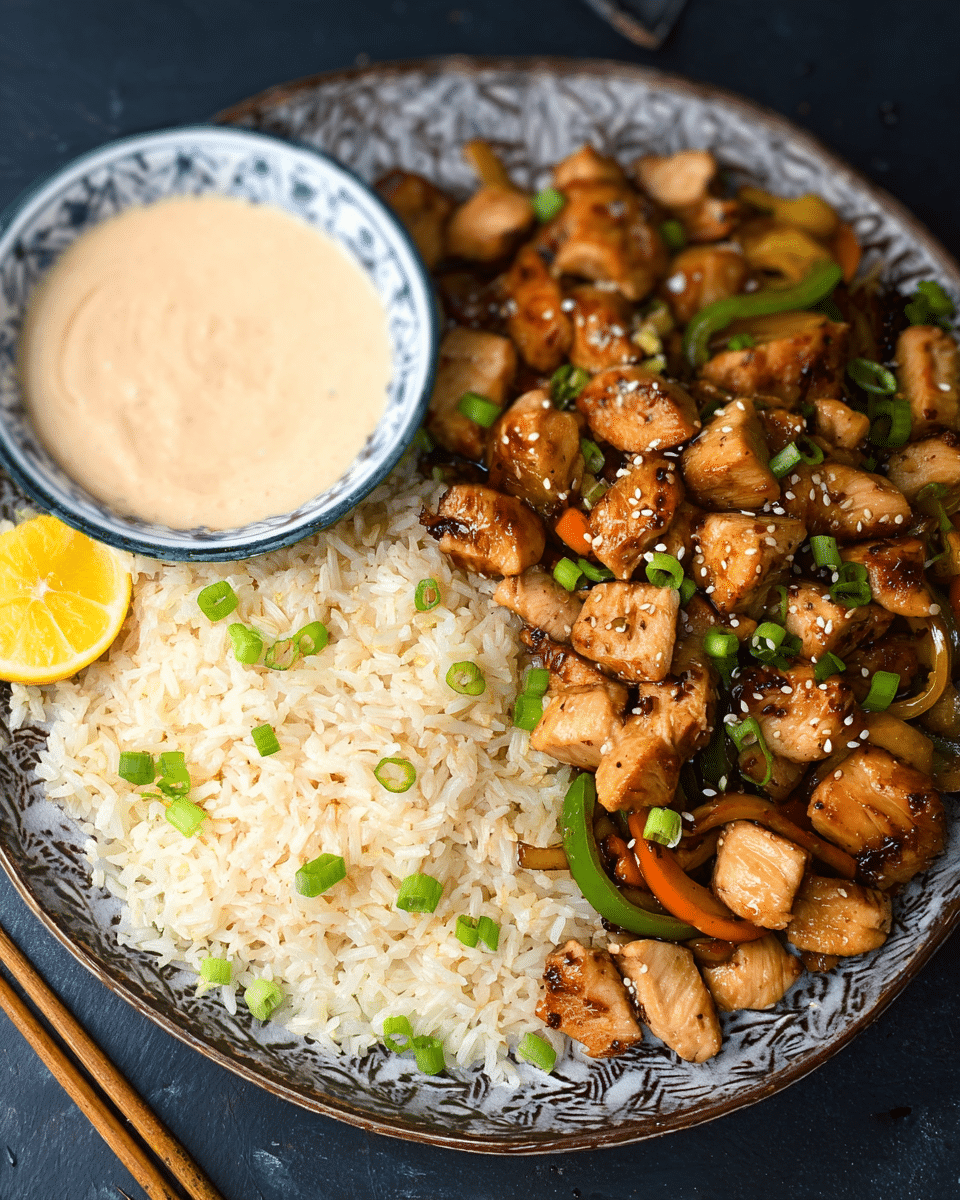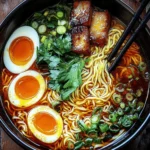The perfect Benihana copycat, this Hibachi Chicken recipe brings all the magic of the Japanese steakhouse experience straight to your stovetop. The combination of tender chicken, buttery garlic, and soy sauce creates a deep umami flavor that feels restaurant-worthy—but is actually fast and simple to whip up at home.
Paired with colorful sautéed vegetables and a rich Hibachi-style fried rice, it’s a complete meal that satisfies every craving. Don’t forget the iconic Yum Yum sauce—it ties everything together with a tangy, creamy sweetness that elevates each bite. Whether it’s a weeknight treat or a weekend dinner show, this dish is guaranteed to impress.
Full Recipe:
For Hibachi Chicken:
-
2 Tbsp butter
-
1.5 lbs boneless, skinless chicken breast, cut into bite-sized chunks
-
3-4 garlic cloves, finely chopped
-
2 Tbsp soy sauce
-
Freshly ground black pepper, to taste
For Hibachi Vegetables:
-
1.5 Tbsp butter
-
1 small onion, cut into chunks
-
1 zucchini, cut into chunks
-
1 large carrot, sliced
-
8 oz mushrooms, sliced
-
1.5 Tbsp soy sauce
-
Pepper, to taste
For Hibachi Fried Rice:
-
4 Tbsp butter
-
1 large carrot, diced
-
1 cup peas
-
1/4 cup corn (optional)
-
3 garlic cloves, finely chopped
-
2 tsp ginger, finely chopped
-
4 cups cold leftover rice
-
2 tsp soy sauce
-
1 tsp sesame oil
-
2 eggs
-
Salt, to taste
For Yum Yum Sauce:
-
1 cup mayonnaise
-
1.5 Tbsp tomato paste
-
1 Tbsp melted butter
-
1 tsp honey
-
1 tsp paprika
-
1/2 tsp garlic powder
-
2 Tbsp water
Directions:
-
Hibachi Chicken: Heat butter in a wide skillet over medium-high heat. Add chicken and sauté for 4–5 minutes until starting to brown. Add garlic and continue cooking for another 3–4 minutes. Stir in soy sauce and pepper. Cook until chicken is fully cooked and nicely seared. Remove and set aside.
-
Hibachi Vegetables: In the same skillet, melt butter. Add onion, zucchini, carrot, and mushrooms. Sauté for 5–7 minutes until they begin to soften. Add soy sauce and pepper. Cook to desired doneness, leaving some crunch. Remove and set aside.
-
Hibachi Fried Rice: Melt butter in the same skillet. Sauté carrots, peas, and corn over high heat for 3–4 minutes. Add garlic and ginger, cook another minute. Add rice, soy sauce, and sesame oil. Mix thoroughly. Push rice to the sides, create a well, and scramble eggs with a pinch of salt. Combine with rice and mix well.
-
Yum Yum Sauce: In a bowl, whisk together all sauce ingredients until smooth.
-
Serve Hibachi chicken with vegetables, fried rice, and a generous drizzle or side of Yum Yum sauce.
Prep Time: 15 minutes | Cooking Time: 30 minutes | Total Time: 45 minutes
Kcal: 610 kcal | Servings: 4 servings
Recipe Overview
If you’ve ever sat around a sizzling hibachi grill at a Japanese steakhouse like Benihana, you know that Hibachi Chicken is more than just a meal—it’s a performance. The tantalizing aroma of butter, garlic, and soy sauce fills the air as a chef works their magic before your eyes. While the experience is often about the show, the food is truly memorable—tender, juicy chicken with that savory seared flavor, paired with vibrant stir-fried veggies, golden fried rice, and a creamy pink dipping sauce known as Yum Yum.
The good news? You don’t need a teppanyaki grill or a chef flipping shrimp into their hat to recreate this mouthwatering dish at home. With a wide skillet or cast-iron pan and a few pantry staples, you can enjoy the same flavors right in your kitchen. This version brings restaurant-quality Hibachi Chicken to your dinner table in under an hour, making it a weeknight winner or an impressive dish for entertaining friends.
History and Origin
Hibachi cooking has deep roots in Japanese culinary tradition. The term hibachi (火鉢) translates literally to “fire bowl,” originally referring to a portable heating device made of ceramic or metal that housed burning charcoal. It was used for warmth, but over time, people began using it to cook food, particularly grilled meats and vegetables. Unlike the high-drama teppanyaki performances popularized in the West, traditional hibachi cooking in Japan was far more modest and home-centered.
What most Westerners call “hibachi” is actually teppanyaki—a style of cooking that emerged in Japan in the mid-20th century and was later brought to America in grand fashion by restaurant chains like Benihana, founded in 1964. Teppanyaki means “grilling on an iron plate,” which is exactly what diners witness at these restaurants: chefs flipping utensils, lighting onion volcanoes, and entertaining as they cook.
Over time, the term hibachi became interchangeable in the U.S. with these high-heat, iron-plate cooking techniques. Today, “Hibachi Chicken” in the West refers to bite-sized chicken grilled or pan-seared with soy sauce and garlic—simple, but utterly flavorful. It’s often served alongside stir-fried vegetables, fried rice, and that signature Yum Yum sauce that brings everything together.
Variations and Adaptations
One of the great things about Hibachi Chicken is how adaptable it is. While the classic version uses chicken breast for its lean texture and mild flavor, you can just as easily use boneless, skinless chicken thighs for a juicier result. Prefer seafood? Swap in shrimp or scallops, which cook even faster and absorb that buttery soy sauce like a dream.
Vegetarian adaptations are also simple and satisfying. Firm tofu, when pan-seared until golden, can stand in beautifully for the chicken. Pair it with plenty of stir-fried veggies—think broccoli, bell peppers, snow peas, and mushrooms—and you’ll have a colorful, protein-packed alternative.
Regionally, different interpretations of hibachi-style meals may incorporate sauces beyond the standard soy. In some fusion variations, teriyaki glaze or spicy sriracha-mayo might replace the traditional Yum Yum sauce. Some recipes also call for a splash of mirin (a sweet rice wine) or sake to enhance umami depth, though this recipe sticks to a simpler, family-friendly profile.
For those who love spice, you can toss in a bit of chili garlic sauce or crushed red pepper flakes to add heat. And if you’re low-carb or grain-free, substitute the fried rice with cauliflower rice—it works surprisingly well!
Nutritional Information
This dish may taste indulgent, but when you break it down, it’s actually quite balanced. A single serving of Hibachi Chicken with vegetables and fried rice (plus a modest dollop of Yum Yum sauce) typically contains around 600–650 calories. The majority of calories come from healthy fats (thanks to the butter), lean protein, and complex carbohydrates.
Macronutrient breakdown (approximate per serving):
-
Protein: 35–40g
-
Carbohydrates: 45–50g
-
Fat: 25–30g
The chicken provides a strong dose of high-quality protein, which helps with muscle repair and satiety. The vegetables are rich in dietary fiber, vitamin C, potassium, and antioxidants—especially zucchini and carrots. The rice offers energy-rich carbs, while the egg contributes both protein and fat, as well as essential vitamins like B12 and choline.
Micronutrient highlights:
-
Vitamin A: From carrots and eggs
-
Vitamin C: From vegetables
-
Iron & Zinc: From chicken
-
Selenium: From eggs
-
B Vitamins: Especially B3 (niacin) and B6, important for metabolism
Serving Suggestions and Pairings
Hibachi Chicken is a full meal on its own, but that doesn’t mean you can’t jazz it up with sides or beverages. Here are a few fun and flavorful ideas to round out your hibachi night:
-
Appetizer: Start with a light miso soup or a crisp cucumber salad with rice vinegar and sesame seeds.
-
Sides: A simple seaweed salad or edamame sprinkled with sea salt complements the rich chicken and rice beautifully.
-
Drinks: Pair this meal with a cold Japanese beer (like Sapporo or Asahi), a crisp white wine (Riesling or Pinot Grigio), or chilled green tea for a non-alcoholic option.
-
Dessert: Finish the meal with a scoop of green tea or black sesame ice cream, or keep it light with fruit skewers dipped in melted dark chocolate.
Serving family-style on a large platter can make this dish even more fun—perfect for gatherings or weekend dinners where everyone digs in!
Tips and Tricks for Success
-
Use Cold Rice: For the fried rice, day-old cold rice is essential. Freshly cooked rice will turn mushy when stir-fried. If you’re in a pinch, spread hot rice on a tray and chill it in the freezer for 15 minutes.
-
High Heat = Great Sear: Use a large skillet or cast-iron pan and cook in batches to avoid overcrowding. You want the chicken and vegetables to sear, not steam.
-
Don’t Skip the Butter: It’s tempting to replace it with oil, but butter brings that signature hibachi flavor. Use it generously for best results.
-
Make the Sauce Ahead: Yum Yum sauce is even better after it sits in the fridge for a couple of hours. Make a batch ahead of time and store it for up to a week.
-
Prep Everything First: This recipe cooks fast. Have all your ingredients chopped, measured, and ready before you start—just like a hibachi chef would!
Potential Health Benefits
While Hibachi Chicken may not scream “health food,” it can be part of a nourishing, balanced diet. The lean protein from chicken helps keep you full and supports muscle health. Garlic and ginger—used in both the chicken and fried rice—are known for their anti-inflammatory and immune-boosting properties.
Advertisement
Vegetables like zucchini, carrots, peas, and mushrooms provide fiber, vitamins, and minerals, all of which support digestion, heart health, and immune function. If you’re using sesame oil in the fried rice, you’ll also get a dose of healthy fats known to support cardiovascular health.
Want to lighten the dish? You can reduce butter slightly, use low-sodium soy sauce, or substitute brown rice for white rice to increase the fiber content.
Conclusion
Hibachi Chicken is a crowd-pleasing dish that delivers maximum flavor with minimal effort. Whether you’re reliving your favorite restaurant experience or creating new traditions at home, this meal is a guaranteed hit. With its crispy, savory chicken, colorful veggies, and umami-packed fried rice, it’s comfort food with a fun twist—and the Yum Yum sauce? Let’s just say you might want to double the batch.
So grab your skillet, turn up the heat, and get ready to bring a little Japanese steakhouse magic to your kitchen. Trust me—you’ll be making this one again and again.





